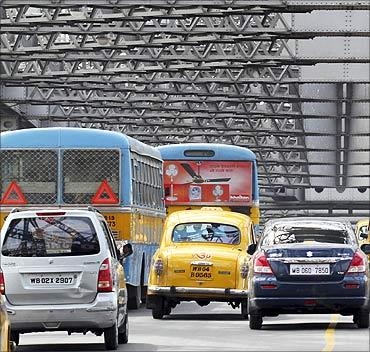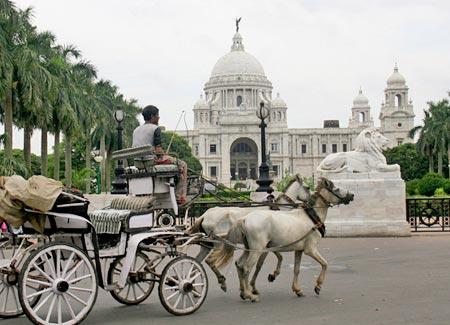 | « Back to article | Print this article |
Debt: West Bengal facing Greece-like tragedy
In March, euro zone finance ministers signed a second Greek bailout package, worth Euro 130 billion.
Probably, taking a cue from this, West Bengal Finance Minister Amit Mitra at a recent industry meet said, "We need to work on debt restructuring, which includes debt elimination.
Click NEXT to read further. . .
Debt: West Bengal facing Greece-like tragedy
"It has been done in the case of Greece and other countries.
"Hence, this can be done for West Bengal too. There is also a need to increase the repayment tenure and reduce the interest rate."
Mitra, however, may have overlooked the price Greece would have to pay for a 53.5 per cent reduction in its debt -- some stringent and unpopular austerity measures like job cuts and steep rise in taxes.
Even as West Bengal Chief Minister Mamata Banerjee is in Delhi for a bailout package, experts suggest moratorium on interest and debt restructuring would be of little help, unless the state's own revenue increased and expenditure was curtailed.
Click NEXT to read further. . .
Debt: West Bengal facing Greece-like tragedy
A look at what West Bengal has been seeking from the Centre: Moratorium on interest and repayment totalling Rs 22,000 crore (Rs 220 billion) on its debt for the next three years and formulation of a debt restructuring exercise over the interim period.
The debt restructuring should include debt elimination, increased repayment tenure and reduced interest rate on loans.
West Bengal's outstanding debt by the end of this financial year is slated to be about Rs 2.26 lakh crore (Rs 2.26 trillion), making it the most indebted state in the country in terms of debt to gross state domestic product ratio at close to 39 per cent.
Click NEXT to read further. . .
Debt: West Bengal facing Greece-like tragedy
Thus, a moratorium without debt restructuring was likely to worsen the financial situation of the state, as in the fourth year the government would have an accumulated debt of more than Rs 66,000 crore (Rs 660 billion), over and above its normal repayment and interest obligations.
"Just a moratorium will only increase the liability of the state government. There is a need for debt restructuring as in the case of Greece.
"But this is not an easy exercise, as any debt restructuring comes with a set of austerity measures," says Dipankar Dasgupta, former professor of economics at Indian Statistical Institute.
Click NEXT to read further. . .
Debt: West Bengal facing Greece-like tragedy
"To improve the financial situation, West Bengal government has to either raise revenue or curtail expenditure," said Devendra Kumar Pant, director, Fitch's International Public Finance team.
However, the state Budget document indicates the Bengal is in no mood to take any major austerity drive.
For example, expense on account of salaries, which constitutes a major portion of the state's expenditure, is set to increase from Rs 28,899 crore (Rs 288.99 billion) to Rs 31,184 crore (Rs 311.84 billion) by the end of this financial year.
Similarly, the cost of pension and other retirement benefits will increase from Rs 8,385 crore (Rs 83.85 billion) to Rs 9,582 crore (Rs 95.82 billion).
In contrast, the state's revenue receipt would be Rs 76,943 crore (Rs 769.43 billion), and its expenditure is slated to be Rs 83,801 crore (Rs 838.01 billion) -- leaving a huge revenue deficit of Rs 6,585 crore (Rs 65.85 billion).
Click NEXT to read further. . .
Debt: West Bengal facing Greece-like tragedy
Yet, attaining the targets would be optimistic, as last year the revenue deficit was at Rs 17,273 crore (Rs 172.73 billion).
Little doubt, the government is already on a borrowing spree.
On April 24, five state governments raised a total of Rs 4,715 crore (Rs 47.15 billion) through state development loan from the Reserve Bank of India.
At Rs 2,500 crore (Rs 25 billion), Bengal accounted for more than half of that sum.
Notably, though Banerjee has been complaining that she had not received any financial assistance in the last one year, the state has got a number of relaxations from the Centre.
Click NEXT to read further. . .
Debt: West Bengal facing Greece-like tragedy
For example, last year, against the original borrowing limit of the state at Rs 17,828 crore (Rs 178.28 billion), West Bengal borrowed more than Rs 20,000 crore (Rs 200 billion) as market loan.
The state availed of the relaxation provided in the Fiscal Responsibility and Budget Management twice in one year.
The second big sop for West Bengal was the sanction of Rs 8,700-crore (Rs 87 billion) as 'backward region development' grant.
Click NEXT to read further. . .
Debt: West Bengal facing Greece-like tragedy
Again, the state got a higher plan outlay from the Planning Commission at Rs 25,910 crore (Rs 259.1 billion) for 2012-13, against Rs 22,000 crore (Rs 220 billion) last year, a rise of almost 17 per cent.
Though Bengal seeks a hefty bail-out package, it has so far not presented any blueprint for utilisation of such funds.
The lone statement on this comes from Mitra, who recently said the moratorium was critical for the state, as the yearly savings of Rs 22,000 crore (Rs 220 billion) would translate into creation of GSDP worth Rs 88,000 crore (Rs 880 billion), according to the theory of Keynesian Multiplier.








